This post was syndicated by BlogHer on October 12, 2012.
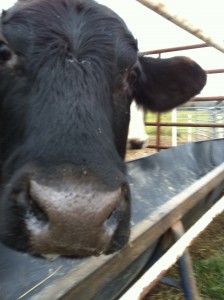
As the school year begins, public school menus across America have been adjusted to align with new federal standards from the Healthy Hunger-Free Kids Act.
President and Mrs. Obama advocated for the passage of this act. It’s federal policy. To be reimbursed by the National School Lunch Program, schools must adhere to these rules.
The new federal standards are designed to promote healthier eating and reduce childhood obesity with choices based on food components rather than nutrients.
Translation: lots of fruits and veggies, not so much meat.
My friend Katie blogged about the new federal standards and why they don’t work for her family. Other women began blogging about the standards, too. They started a Facebook page called Sensible School Lunches to dialogue.
I pay taxes that support public schools and these programs. So do you. We pay regardless of whether or not we have children enrolled. The well-being of the children in a community is important to the community as a whole.
That makes us all stakeholders in this.
The new federal standards recommend children in kindergarten through fifth grade receive more than six cups of fruits and vegetables for lunch per week, but only eight to 10 ounces of meat or meat alternative for lunch per week.
You read that right. Per week.
That’s roughly two ounces of meat per lunch.
Two ounces of meat per lunch didn’t sound like much to me, but I wasn’t really sure. My son and I headed to our local market to find out.
Two ounces (.125 pounds) of raw ground beef is about one meatball. Enough for a small hamburger or a portion of spaghetti sauce. Not bad.
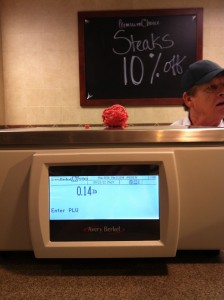
Consider the chicken leg. It’s overweight at .31 pounds (4.96 ounces).

Two slices of bacon is fine, but a two-slice limit wouldn’t go well at my house.
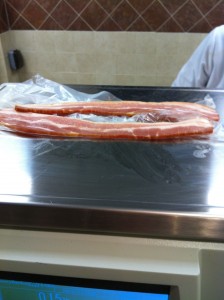
At another store, we determined one hotdog would pass.
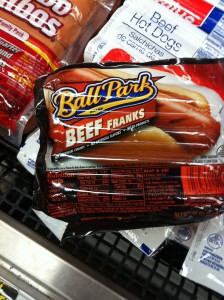
So would a package of lunch meat like this.
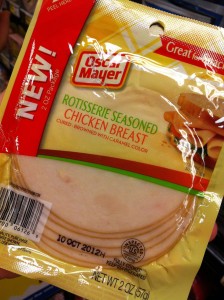
My son enjoyed our investigative reporting. But as I snapped photos of Oscar Mayer, I wondered what the menu changes meant in real life.
I consulted the USDA’s sample menus.
Will children really eat 1/4 cup of jicama and 1/4 of pepper strips as suggested for the Monday menu, assuming they know what jicama is? How about Tuesday’s suggested 1/2 cup of broccoli and 1/2 cup of cauliflower?
Who are these kids? We try at our dinner table. We really do, but it’s a win if the child ingests more than one green bean.
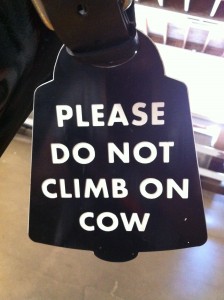
By the time Friday rolls around, the weekly allowance of meat on the sample menu has been depleted. Cheese pizza is the suggested fare. Why not front-load the week with this deficit and participate in Meatless Mondays?
I jest, but there are American ranchers who are not amused.
The new federal standards also prohibit whole milk or flavored milk, a fact highlighted in Joslyn Gray’s post Seriously? 15 Things Schools Have Banned So Far in 2012. By 2014, the only grains allowed will be whole grains.
Let’s say a child eats his veggie-rich lunch of jicama and peppers with two ounces of turkey and one cup of fat-free milk, but is still not hunger-free. How will that child perform in class?
What if that child’s only meal for the entire day is school lunch?
Sadly, this is the case for many students. The 2010 Hunger in Our Schools study concluded hunger remains a problem in the classroom with a large proportion of students relying on school meals. It’s the main reason some kids come to school.

The Healthy Hunger-Free Kids Act updates public school menus for the first time in 15 years. It’s a commendable start.
The emphasis on fruits, veggies, whole grains, and low-fat milk is terrific. Still there are questions that need to be addressed for these standards to succeed in real life.
Giving local schools more say in what works best in their communities with their students makes the most sense.
Local schools are also better equipped than the federal government to network with area farmers and ranchers to supply foods, another goal of the Healthy Hunger-Free Kids Act.
There’s work to be done. Please contact your elected officials. Visit Sensible School Lunches to learn more and to dialogue. Bloggers, consider writing your story about this topic and sharing it there.
He always does what He says—
He defends the wronged,
He feeds the hungry. Psalm 146:7 The Message
And now the moment you’ve all been waiting for. A link to the Wendy’s commercial that inspired this post’s title: Where’s the Beef?
What’s your take on the new menus?

Great article, I just linked to it in the post I did on choices and the need for nutrition education that helps kids see why their food matters. Thanks for your great homework.
Oh, yeah! Thanks, Michele. I’ll see if I can find your post and include a link here. I’m sure others will find it helpful!
Here’s the link to Michele’s post. She includes more facts, plus contact info for Undersecretary of Food and Nutrition Services Concannon and Secretary of Agriculture Vilsack :)
http://www.causematters.com/advocacy/fat-kids-government-lazy-parents/
Thanks, didn’t want you to think I was doing a pitch on your blog comments. :)
Thanks for your graciousness, Michele. I struggle with knowing whether to link to a post in a comment on someone else’s blog, too. I’ve read it’s bad manners, but I want my readers to have the opportunity to see what others are saying and thinking. I don’t know everything (surprise). Links add to the conversation IMO. You are welcome to include links here :)
I love this, Aimee. Thanks for doing the homework. As a livestock producer the new meat guideline doesn’t bode well with me and it goes far beyond meat sales — we’re too small to sell to channels that end up in school lunch rooms anyway. For me it boils down to that hunger you mentioned. Protein is so important to satiating hunger. It saddens me that many kids still won’t be getting what they need.
There is something unethical about keeping food from people who need it whether it’s by unwise, protein-free menu choices in food lunches or blocking technology that can produce more food for more people or limiting food choices by pitting foods and farmers against each other. Thanks for reading and commenting, Diana. I’m honored by your visit!
What a great project to do with your son and this is a very good article. Thanks.
Thank you for reading. It was fun to do an “investigative” report together. It brought up more questions for us–maybe we’ll search for answers in future posts.